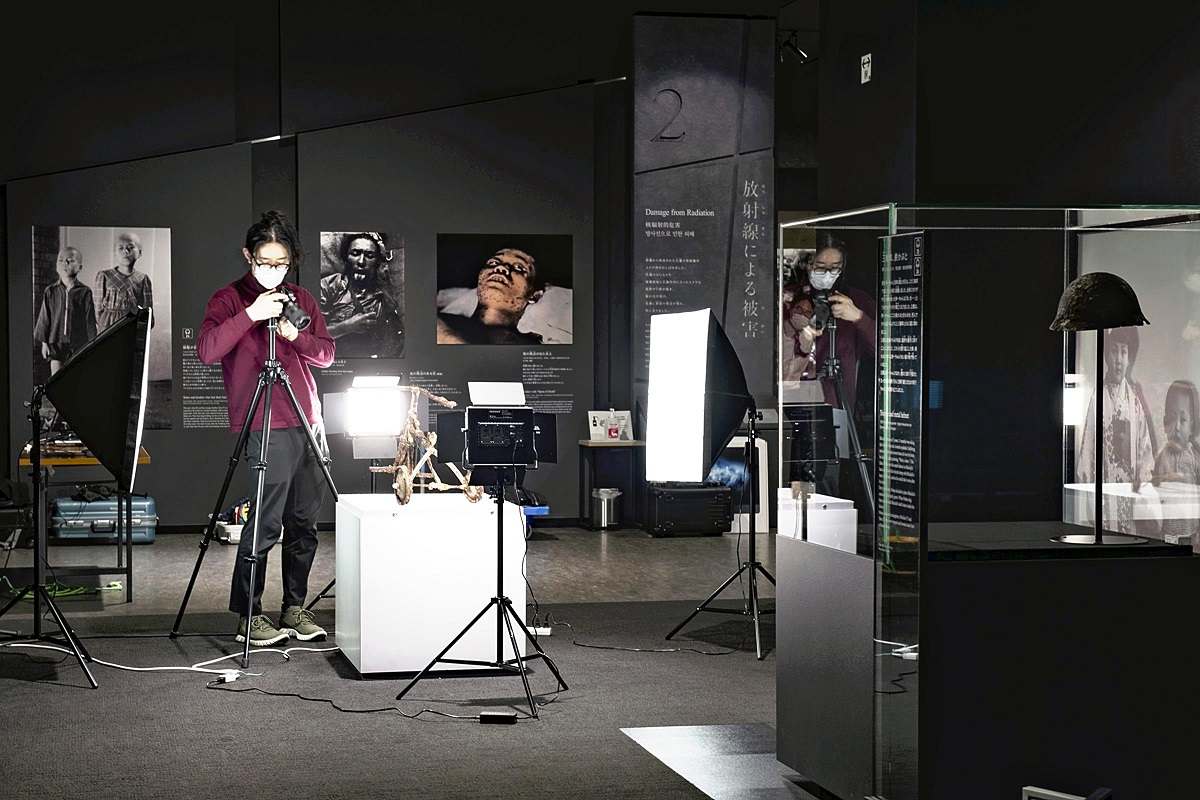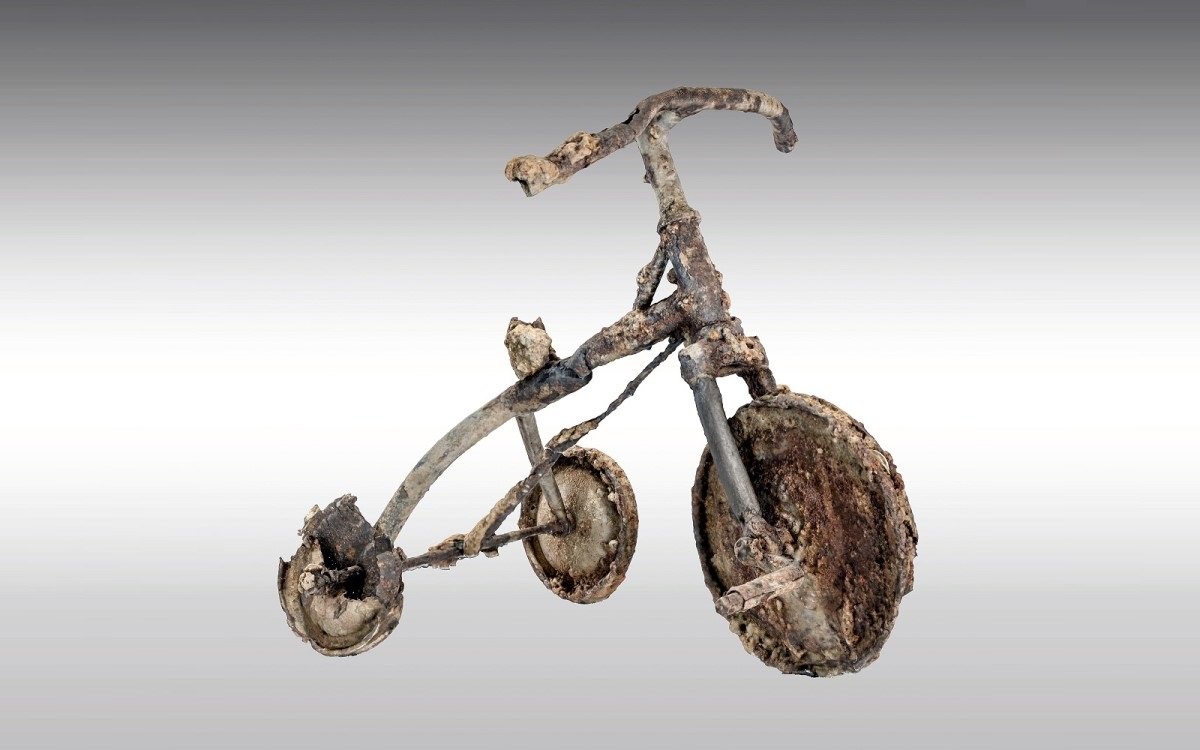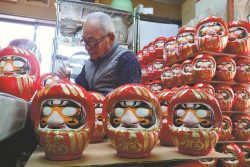Artwork Based on A-Bombed Tricycle to Be on Permanent Display at Geneva Museum; Japanese, U.S. Artists Collaborate to Convey Memories

A person digitally scans a tricycle hit by an atomic bomb.
16:30 JST, September 3, 2024
HIROSHIMA – A bronze artwork based on the tricycle of a child killed in the atomic bombing of Hiroshima will be on permanent display at the International Red Cross and Red Crescent Museum in Geneva from Sept. 19.
Japanese artist Akira Fujimoto and U.S. artist Cannon Hersey based their life-size sculpture “Future Memory Tricycle” on the tricycle displayed at Hiroshima Peace Memorial Museum in Hiroshima City. Through the artwork, the artists aim to demonstrate the inhumanity of nuclear weapons and the reality of the atomic bombing.
“Future Memory Tricycle” was commissioned by the Geneva-based International Campaign to Abolish Nuclear Weapons (ICAN) and will be donated to the Geneva museum.
The tricycle on which the artwork is based belonged to Shinichi Tetsutani, a 3-year-old boy who died in the blast. The boy was riding the tricycle at his home in Hiroshima on Aug. 6, 1945, when the atomic bomb was dropped. His home was 1.5 kilometers away from the hypocenter.
He is said to have been severely burned and to have died that night.
The tricycle was once buried with the boy in the garden of his home but was dug up in 1985 and donated to the Hiroshima museum by his father, Nobuo.
Nobuo died in 1998 at the age of 88.

The digitally scanned, three-dimensional data of an atomic-bombed tricycle
As one of the representative exhibits at the Hiroshima Peace Memorial Museum, the tricycle, known as “Shin-chan’s tricycle,” conveys the brutality of nuclear weapons and the reality of the Hiroshima bombing as it was experienced on the ground.
Former British Prime Minister Rishi Sunak reportedly said he was deeply moved by the exhibit when he visited the Hiroshima museum during a Group of Seven summit in May last year. Sunak reportedly said the leaders who saw the tricycle will never forget what happened in Hiroshima.
Beatrice Fihn, former executive director of the ICAN, is also said to have been moved by Shin-chan’s tricycle when she saw it in 2018. It was Fihn who came up with the idea to display an artwork based on the tricycle at the ICAN and the United Nations Office at Geneva.
Hersey, a grandson of the journalist John Hersey (1914-93) who reported the devastation of Hiroshima to the world one year after it occurred, has been working on artistic projects that convey memories of wars, disasters and the atomic bombings. In summer 2020, he built a website that simulates the exhibition space in the Hiroshima Peace Memorial Museum.
With the consent of the boy’s surviving family members and the cooperation of the museum, Hersey and Fujimoto spent about a year from spring in 2021 creating the bronze sculpture based on three-dimensional data made by combining more than 100 high-resolution photographs of Shin-chan’s tricycle taken from 360 degrees.
“Shin-chan’s tricycle has the power to make people understand that there were people in Hiroshima before and after the bombing,” said Akira Kawasaki, an International Steering Group member of the ICAN.
“We hope that by placing the artwork in Geneva, the world’s center for disarmament negotiations and humanitarian assistance, we can continue to send the strong message that no child should become the victim of a nuclear weapon, like Shin-chan did,” Kawasaki said.
"Society" POPULAR ARTICLE
-

M4.9 Earthquake Hits Tokyo, Neighboring Prefectures
-

Israeli Tourists Refused Accommodation at Hotel in Japan’s Nagano Pref., Prompting Protest by Israeli Embassy and Probe by Prefecture
-

M7.5 Earthquake Hits Northern Japan; Tsunami Waves Observed in Hokkaido, Aomori and Iwate Prefectures
-

Tsukiji Market Urges Tourists to Avoid Visiting in Year-End
-

High School in Kyoto Says Students Shoplifted during Recent School Trip to Bali, Indonesia
JN ACCESS RANKING
-

Tokyo Economic Security Forum to Hold Inaugural Meeting Amid Tense Global Environment
-

Keidanren Chairman Yoshinobu Tsutsui Visits Kashiwazaki-Kariwa Nuclear Power Plant; Inspects New Emergency Safety System
-

Imports of Rare Earths from China Facing Delays, May Be Caused by Deterioration of Japan-China Relations
-

University of Tokyo Professor Discusses Japanese Economic Security in Interview Ahead of Forum
-

Japan Pulls out of Vietnam Nuclear Project, Complicating Hanoi’s Power Plans

























